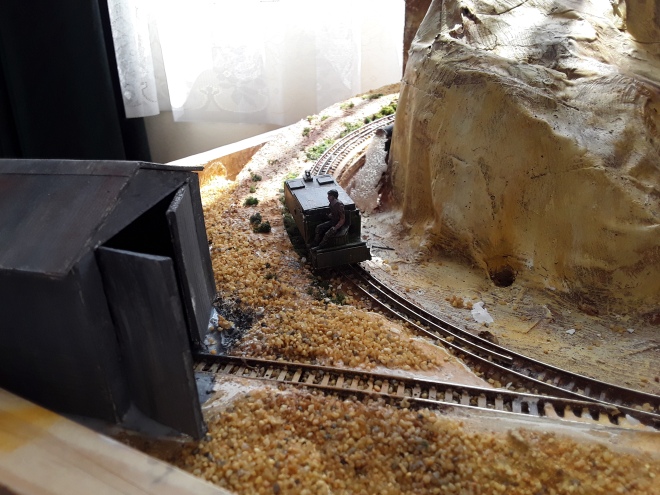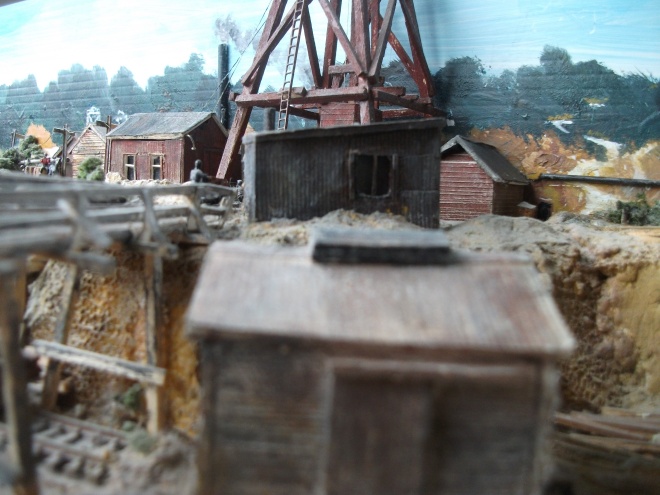I have long been interested in the nineteenth-century underground gold mines of New Zealand’s Coromandel Peninsula. The need to develop these mines to their fullest potential required very large amounts of money and the latest technology – at that time only available from London, the financial and mining-technology centre of the world. Thus were British capital, Victorian-era steam-powered machinery and British manufacturing skills brought to bear on the Coromandel.
However, two problems needed to be solved: how to remove the gold-bearing rock in the most efficient manner, and having done this, how to extract as much gold as possible. The pursuit of these aims constituted New Zealand’s first heavy industry of any consequence. Developing the necessary technology, especially the use of potassium cyanide for gold-extraction, meant that for a period the New Zealand quartz gold mining industry led the world.
In one way the Te Kereru Mining and Investment Co Ltd. layout is a homage to this era and industry. In another it is also a teaching tool, showing in miniature how things were in ‘the olden days’, and introducing the viewer to a little-known aspect of New Zealand history.
The Backstory
1893: While hunting Kereru (Hemiphaga novaeseelandiae; the New Zealand Pigeon) in the hills of New Zealand’s Coromandel Penisula, W.V. James discovers a gold and silver-bearign reef (‘lode’) near Toi Toi Creek – somewhere north of Karanagahake, and south of Port Jackson.
1895: The Te Kereru Mining and Investment Company (Limited. is formed in London and is soon driving horizontal tunnels (or adits) into the reef to explore the size of the deposit and commence the mining of the ore it contains.
1897: The Company begins constructing a 40-stamp battery / reduction-works for use in conjunction with the recently-introduced MacArthur-Forrest cyanide process. The work includes the construction of a steam-powered railway to connect the mine workings with the battery. This required the construction of a short tunnel through an adjacent ridge.
1898 (November); Ore trains begin running.
1900: Having found that the reef system descends much deeper than can be reached via horizontal adits, the Company sinks a shaft (the Toi Toi) to better mine the reef and to prospect further.
1901: The Toi Toi Shaft reveals that the reef system is increasing in value as it descends, and as a result, an additional 20 stamps are added to the battery.
1911: The cyanide plant is updated. This includes four tall Brown and McMiken (B&M) air-agitator tanks measuring 13.7 metres x 6.0 metres( 45 ft. x 20 ft.) placed towards the rear of the site. A vacuum-filtration plant and hydraulic classifier are also added.
1913 (The present time): The Company’s upgrades are payign off and its gold and silver production is the alrgest within the district. The Toi Toi Shaft is currently 144.7 metres (475 ft.) deep and values are showing no sign of decreasing at this depth.
The Model
Te Kereru (pronounced Tea -Care-Rare-Roo) was intended to portray by way of a small layout, the main elements in this fictional history, a scenario that drew heavily on large-scale gold mines once found at Thames, Karangahake (Car-rang-ah-hack-ee) Komata (Co mah-tah), Coromandel and Waihi (Y-he) These and my own personal experiences provided the technical background.
My intention was always to make Te Kereru a technically and historically accurate portrayal of a neglected part of New Zealand’s history. I wanted the layout to be in N scale, portable, and able to fit between my car’s rear wheel arches. And it had to be ready for public exhibition within three months! It was, and at that and several other exhibitions has received encouraging comments from both the public and other modellers.
Of course I did not start from scratch. Te Kereru is the final development of a series of micro layouts beginning in 2006 with the Kaisers Reef (Hauraki) Gold Mining Co (NL) cutlery drawer-based layout seen at the 2008 New Zealand Model Railway Guild convention in Taradale (Napier). I subsequently enlarged the ‘Kaiser’s concept, and created the ‘Te Kereru Mining and Investment Co Ltd’ , (‘Te Kereru’ being pronounced: Tea Care-rare-roo), a portable ‘clockwork mouse’ layout designed for exhibitions and, for ease of transportation, capable of fitting in between the wheel arches of my Nissan Primera sedan’s rear seat.
Construction
The baseboard measures 1066mm x 508mm (3ft 6in x 2ft), comprising a sheet of MDF with strips of 20mm x 30mm pine glued on the outside edges to form a frame for a 12.7mm–thick sheet of ‘Pinex–brand soft-board laid on top. A three-ply scenic divider conceals a small fiddle yard and work area, while a tall ridge separates the site of the Toi Toi (Toy-toy) Creek mining operations from the ore processing area. I have employed self-developed a New Zealand-specific variation of UK N scale (1:148), with suitably modified N-scale rolling stock.
Track and wiring
The track is roughly oval in shape, laid with Peco N scale Code 80 flextrack pinned to the Pinex. Exhibition-based experience and discussions with respected model railway peers convinced me that points can be a source of many problems, and since the viewing public rarely commented it seemed that omitting them would be a contribution to reliable running. The layout does however have three nominal sidings (at the mine, the battery and the locomotive shed beside the battery). These are supposedly one-blade mining tramway type units and are non-working.
Power feed is simply two wires attached to my veteran Hammant & Morgan power unit.
Scenery
Basic scenery was constructed from blocks of high-density plastic foam overlaid with kitchen towels. Pollyfilla was applied over this, followed by acrylic tube colours, predominantly white, black, yellow ochre, burnt sienna, yellow and blue. Vegetation is Woodland Scenics Coarse Foliage. Ground cover consists of a variety of dried sawdusts, held in place by PVA and superglue.
The sky is deliberately white in colour — to help portray the anti-cyclonic gloom frequently found on the Coromandel Peninsula and emphasises the contrast between the bush and structures. Comments from residents of the area, indicate that I have successfully captured the atmosphere of the area.
Structures
All Te Kereru’s structures are scratch-built, designed to provide examples typical of the various evolutionary phases of large-scale nineteenth century underground goldmines in the Coromandel.
As well as the major mine and battery buildings there is a water-race, with race inspector’s hut, a locomotive shed; goods sheds at both the mine and battery, and various other tanks and buildings.
At Toi Toi there is a substantial amount of trestle work and a large dump for waste rock (mullock) from the mine.
An abandoned traction engine remains at Toi Toi from when it served as a stationary boiler to power an air compressor in the mine’s early days. Contrast that with the new fangled telephone recently installed to connect the General Manager’s office at the battery Te Keruru office with the Mine Manager’s at Toi Toi.
The tall B&M (Brown and McMiken) air-agitator tanks at the battery form part of the battery’c cyanide plant and are typical of early examples, while the Toi Toi Shaft’s 65ft (20m)-tall head frame (or Poppett Head) is similar to those at Thames, Waihi and Coromandel.
Material and methods
A wide variety of discarded materials were used in constructing Te Kereru. Almost everything was made from off-cuts, such as the scraps of picture framer’s matte board used for buildings, or the discarded overhead transparency film used for window glazing.
The battery’s windows, having multiple panes, were first scribed to create the mullions, then covered with white paint, which when wiped off with a damp cloth left paint within the scribed lines – instant multi-paned windows!
Mining plant, having only a short life-expectancy, was constructed as cheaply as possible, and in New Zealand low-cost corrugated iron was the primary form of cladding. My ‘corrugated iron’ was 1970s-era embossed wallpaper and I made the B&M tanks from toilet-roll inners, with propelling-pencil leads being used for over-flow pipes and card for the deflectors installed at the tops of the tanks. . . The Toi Toi Shaft head frame was built from square-section strip balsa and card, and the mine ore trucks from cork roadbed, with propelling-pencil leads for the axles. Items I could not make, (such as track, people and animals), were purchased.
Detailing
I enjoy the possibilities for detailing, and as a result various small vignettes appear on the layout. These include a cage in the Toi Toi Shaft head frame with a worker putting a lot of effort into manoeuvreing an empty ore wagon back inside before it returns underground, two men using a pinch-bar to get an ore-truck back on the rails at the entrance to one of the tunnels, and the telephone-line repairman up a pole near the water-race, replacing a line that has been broken. His two pack-horses (one carrying saddlebags) graze below him. There are other similar mini scenes as well, though they may not be evident at first glance.
Rolling stock
Motive power is an N-scale Bachmann 0-6-0 Plymouth switcher reworked to look something like a Manning-Wardle street tramway locomotive. This was supposedly imported by the company from a bankrupt British system. Wagons are scratch-built, mainly of the mainly of the side-tipping-type and mounted on single N-scale bogies’.
Several flat-deck wagons do static duty at the goods sheds at Toi Toi and the battery. Because of the severe curvature, a simple type of hook and pin coupler is used. At the standard N scale viewing distance of two feet (600mm), these rarely elicit comment.
People and creatures
Te Kereru has various people and animals within its boundaries. People are doing a variety of jobs, from shovelling coal outside the battery’s boiler house, to the telephone-line repairman previously-mentioned. At Toi Toi, pit ponies haul ore and timber wagons as needed.
Things that lurk in the forest
There is a resident dinosaur in the bush country between the battery and the mine. A reclusive creature, it is only seen at exhibitions, mainly by small children. He has proven singularly successful as an ice breaker with members of the public. With the children indulging in a dinosaur hunt the parents can be engaged in conversation and left free to actually look at what is on the layout.
Is it narrow gauge?
I am frequently asked if the layout is 009 or some narrow gauge variation on Z gauge (Nn3 perhaps). The questioners are invariably surprised that it is in fact conventional N scale, rather than the apparent narrow gauge that prompted the question. The narrow gauge look is not intentional, but seems to have evolved of its own accord. For that I have no explanation.
Public reaction
My wife accompanies me to exhibitions, and she has noted that because of the clockwise direction that model railway exhibitions tend to follow, members of the public mostly approach from the Te Kereru or battery (left hand) end. Having given the layout a quick once-over, and seeing little to interest them, they then move on, to suddenly notice Toi Toi at the other end, hiding behind some hills and trees. The reaction is frequently one of surprise accompanied by a ’wow’ of amazement, and followed by a closer investigation. Some people have even been observed dragging their mates back to share in the discovery.
Frequent comment is made concerning the detail that has been incorporated into Te Kereru, along with surprise as to how much detail is possible in such a small scale and space. We have also noticed that because of its height — it simply rests on a conventional trestle table — small children and people in wheelchairs seem to get the best of views.
The future?
Te Kereru has so far attended several exhibitions and been well received. It is reliable and fun and gets lots of positive comments from viewers, so its appearances will continue. In between times it is still being detailed and added to.
Layout at a glance
Name: Te Kereru Mining and Investment Co. Ltd.
Scale: N (1:148).
Size: 1.066.8mm x 508mm. (42″ x 24″).
Prototype: Various Coromandel Peninsula gold mining tramways.
Period: 1913.
Locale: Coromandel Peninsula, North Island, New Zealand
Layout Style: Portable.
Height: Approximately 1m (height of trestle table).
Length of mainline: 2.72m.
Track: Peco code 80 flextrack
Points/Turnouts: None.
Control: Conventional 240-volt transformer.
_______________________________

TE KERERU MINING AND INVESTMENT CO. LTD.
General view of layout showing Toi Toi mining area at bottom of layout and battery/ reduction-works site visible at upper LH corner.
(Scale: 1:148)

TE KERERU MINING AND INVESTMENT CO. LTD.
Detail view of Toi Toi Mining area showing various adits and tramways. Poppett Head of Topi Toi shaft visible at center-right foreground.
(Scale: 1:148)
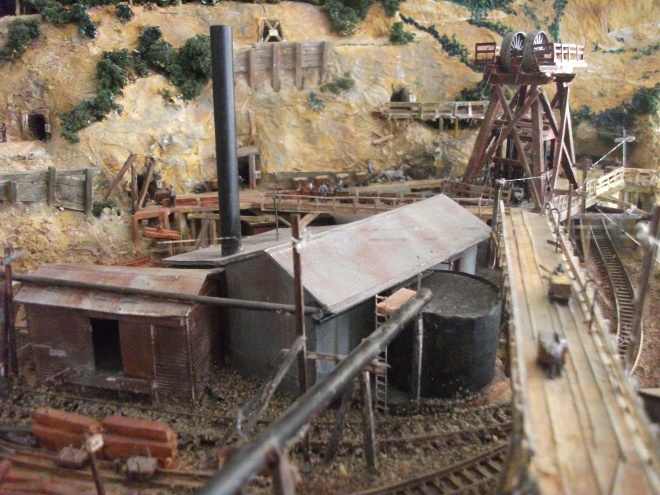
TE KERERU MINING AND INVESTMENT CO. LTD.
A view from Mullock heap (Waste rock) area showing surface buildings associated with the Toi Toi shaft. The tramway goods shed and the tracks of the steam-powered tramway. are visible at LH centre and at bottom of the image. Various adits and mining-related tramways are visible in the background.
(Scale: 1:148)

TE KERERU MINING AND INVESTMENT CO. LTD.
View along Mullock Heap trestle, looking towards Toi Toi shaft
(Scale: 1:148)
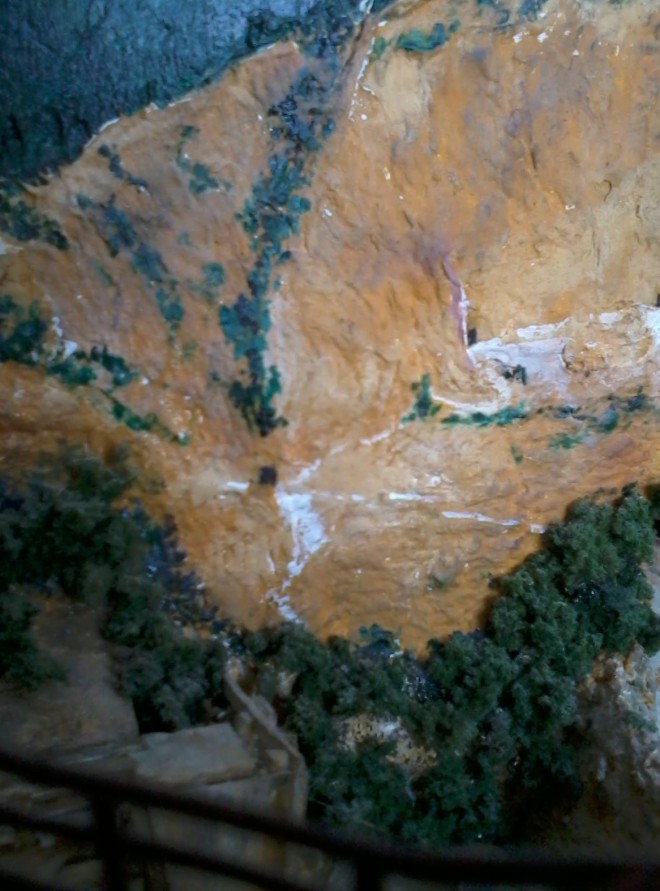
TE KERERU MINING AND INVESTMENT CO. LTD.
View of Upper Toi Toi Valley showing various adits and mullock heaps (Waste rock dumps).
(Scale: 1:148)

TE KERERU MINING AND INVESTMENT CO. LTD.
Braceman maneuvering ore wagon into cage on upper Brace of Toi Toi shaft.
(Scale: 1:148)

TE KERERU MINING AND INVESTMENT CO. LTD.
View of western section of Toi Toi mine workings, showing No.6 adit and ore-Bins and steam-powered tramway tracks. The Toi Toi Shaft and Winding-Engine House is visible in background.
(Scale: 1:148)

TE KERERU MINING AND INVESTMENT CO. LTD.
Steam-tramway locomotive No.1 arriving at the battery with a rake of wagons. General view of 60-stamp battery/reduction works and cyanide plant. B&M tanks visible at left, with tracks of steam-powered tramway visible at bottom of photograph.
(Scale: 1:148)

TE KERERU MINING AND INVESTMENT CO. LTD.
A general view of the battery / reduction-works area The 60-stamp battery is in the taller part of the large building that also houses the cyanide plant. There is a hand-fired boiler in the smaller foreground shed. The tracks of the steam tramway are just visible
(Scale: 1:148)

TE KERERU MINING AND INVESTMENT CO. LTD.
Detail image of the modern Brown and McMiken Air-agitator tanks installed at the Te Kereru Mining and Investment Co. Ltd.’s battery in 1912.
(Scale: 1:148)

TE KERERU MINING AND INVESTMENT CO. LTD.
Aerial view of Battery, Company offices, Cyanide plant B&M Tanks, Pump House Tailings Dam and Locomotive Shed.
(Scale: 1:148)

TE KERERU MINING AND INVESTMENT CO. LTD.
A detail view of the Company’s water-race headstock and siphon, with waste water discharging over the spillway to the right. The Water-race Inspector is visible on the bridge, while his hut is visible behind the telephone pole.
(Scale: 1:148)
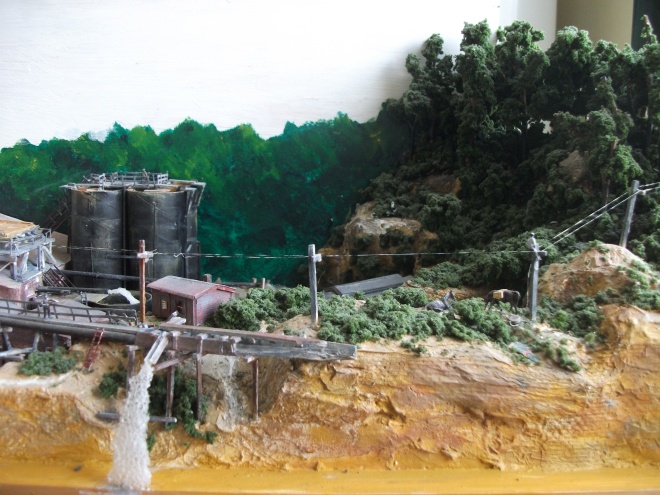
TE KERERU MINING AND INVESTMENT CO. LTD.
An image of the Company’s water-race and its recently-installed and modern telephone system which connects the Battery with the mine. A recent storm has removed the wires so a repairman can be seen on top of the pole, reconnecting the line. His pack horses are grazing patiently below him.
(Scale: 1:148)

TE KERERU MINING AND INVESTMENT CO. LTD.
Tramway locomotive shed.
(Scale: 1:148)
__________________________
Note: No photographs of the dinosaur have been discovered.



